Managing Productivity Through People in Hospitality
VerifiedAdded on 2020/04/01
|7
|1561
|301
Essay
AI Summary
The assignment focuses on 'Managing Productivity Through People' in the context of Hospitality Management. It evaluates how Human Resource Management (HRM) practices impact productivity and organizational commitment within Marriott International. The report highlights key HRM policies such as talent management, legal and ethical standards, community support, and global social responsibilities like poverty alleviation and diversity inclusion. These practices are crucial for maintaining high employee performance and aligning with Marriott's uncompromising commitments to human rights and environmental sustainability. Furthermore, it discusses the importance of extending comprehensive HR policies from entry-level positions to higher managerial roles, emphasizing future planning and community involvement. The assignment underscores that effective HRM not only enhances productivity but also strengthens organizational commitment by adhering to ethical standards and supporting diverse global communities.
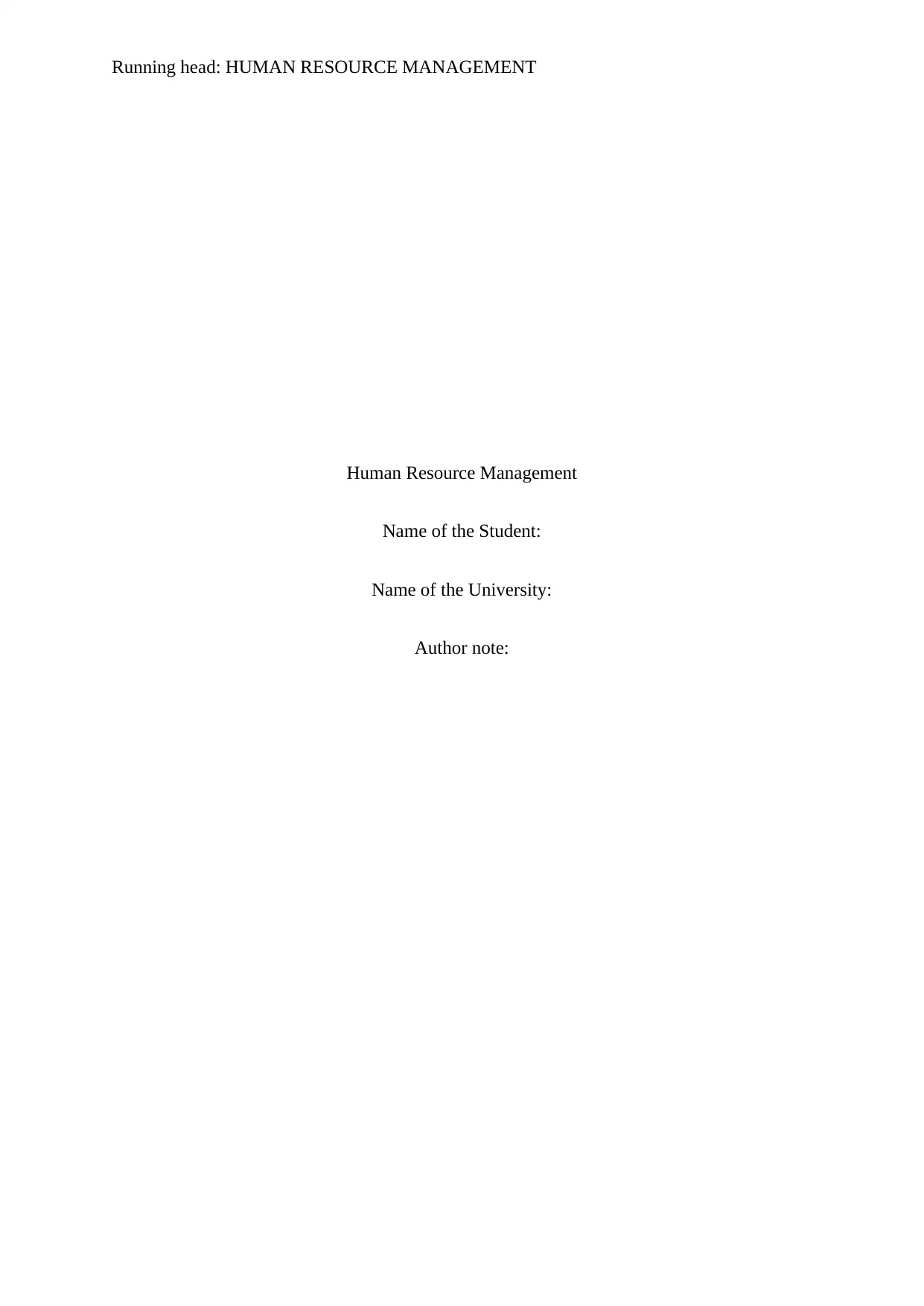
Running head: HUMAN RESOURCE MANAGEMENT
Human Resource Management
Name of the Student:
Name of the University:
Author note:
Human Resource Management
Name of the Student:
Name of the University:
Author note:
Paraphrase This Document
Need a fresh take? Get an instant paraphrase of this document with our AI Paraphraser
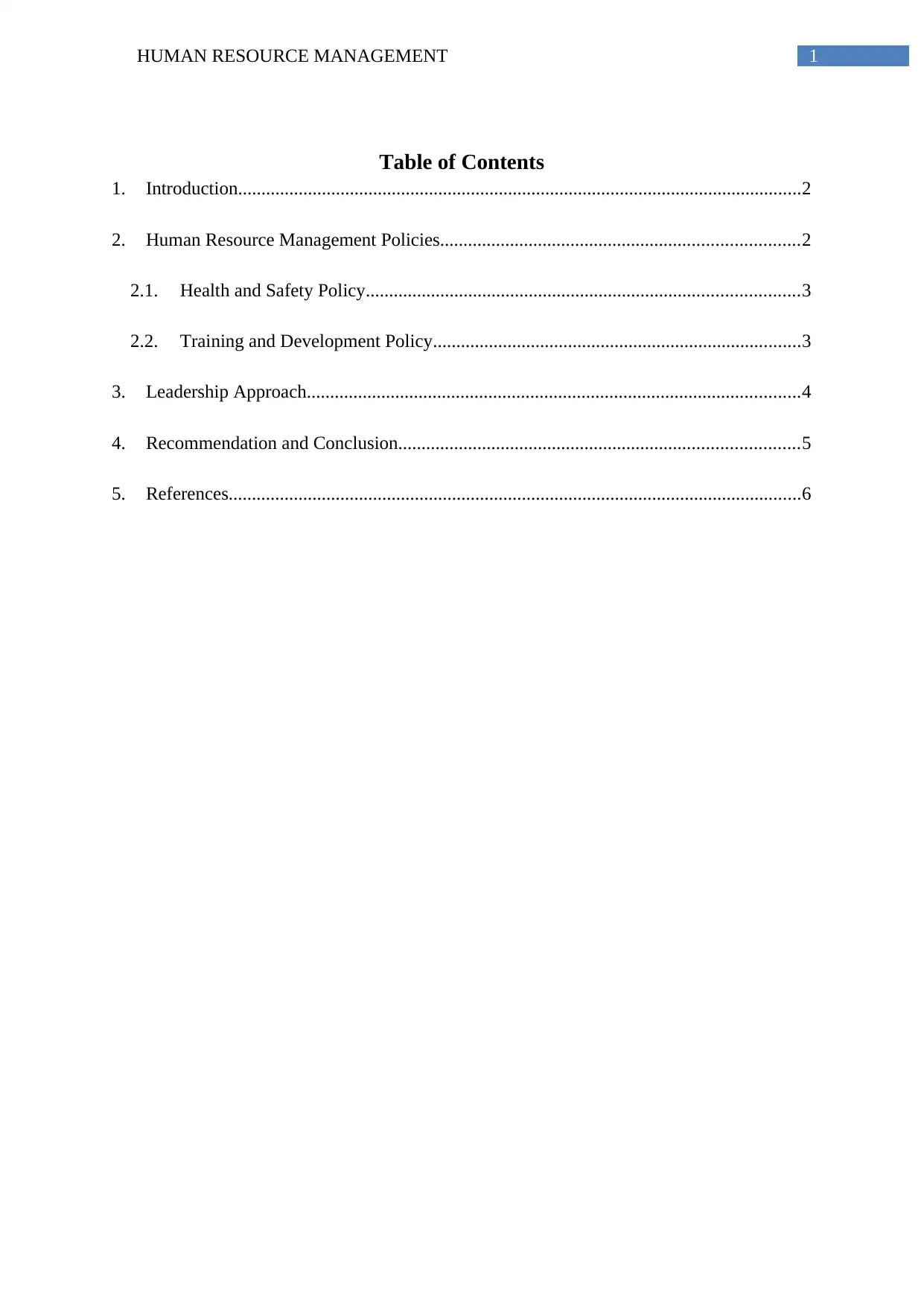
1HUMAN RESOURCE MANAGEMENT
Table of Contents
1. Introduction.........................................................................................................................2
2. Human Resource Management Policies.............................................................................2
2.1. Health and Safety Policy.............................................................................................3
2.2. Training and Development Policy...............................................................................3
3. Leadership Approach..........................................................................................................4
4. Recommendation and Conclusion......................................................................................5
5. References...........................................................................................................................6
Table of Contents
1. Introduction.........................................................................................................................2
2. Human Resource Management Policies.............................................................................2
2.1. Health and Safety Policy.............................................................................................3
2.2. Training and Development Policy...............................................................................3
3. Leadership Approach..........................................................................................................4
4. Recommendation and Conclusion......................................................................................5
5. References...........................................................................................................................6
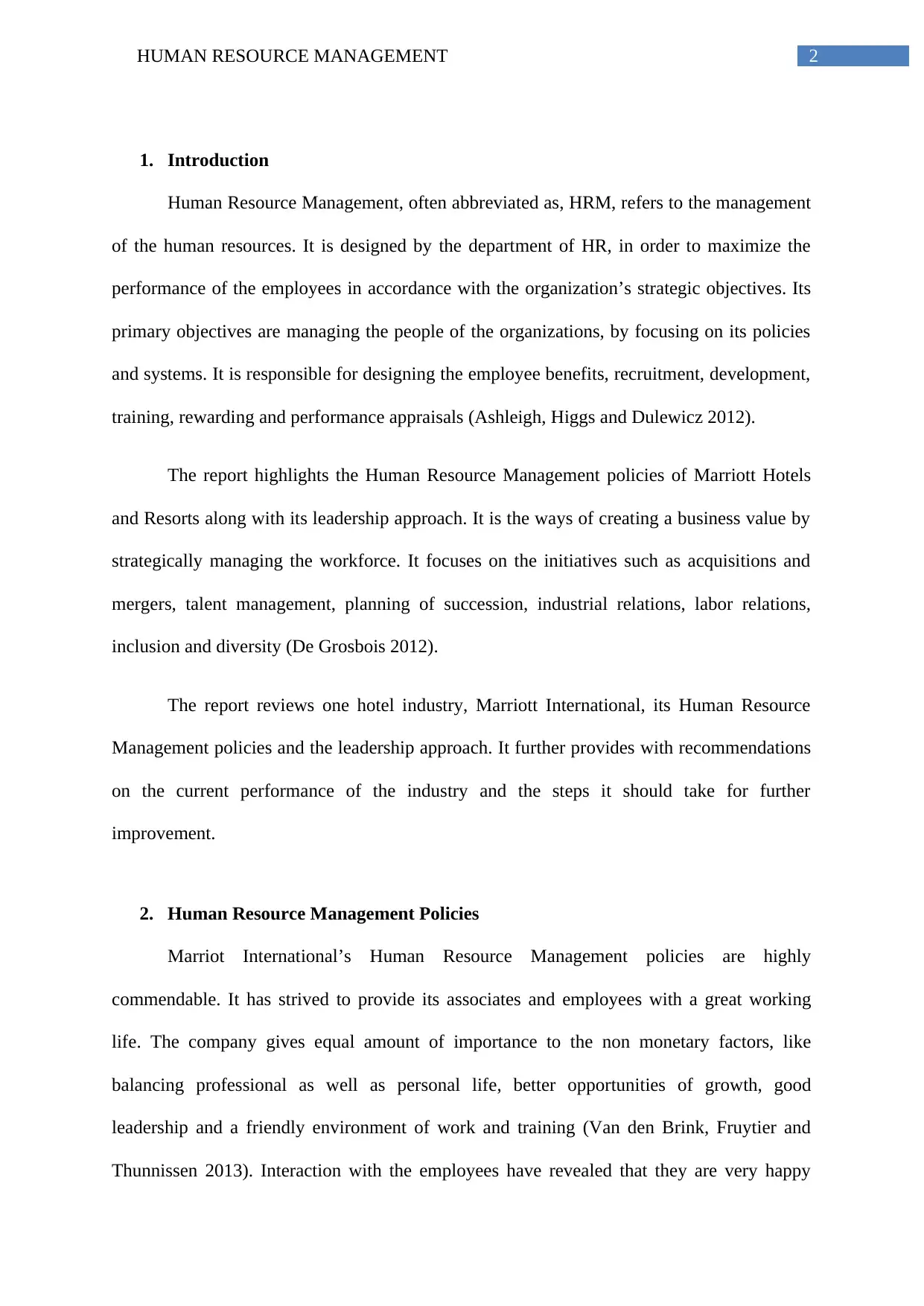
2HUMAN RESOURCE MANAGEMENT
1. Introduction
Human Resource Management, often abbreviated as, HRM, refers to the management
of the human resources. It is designed by the department of HR, in order to maximize the
performance of the employees in accordance with the organization’s strategic objectives. Its
primary objectives are managing the people of the organizations, by focusing on its policies
and systems. It is responsible for designing the employee benefits, recruitment, development,
training, rewarding and performance appraisals (Ashleigh, Higgs and Dulewicz 2012).
The report highlights the Human Resource Management policies of Marriott Hotels
and Resorts along with its leadership approach. It is the ways of creating a business value by
strategically managing the workforce. It focuses on the initiatives such as acquisitions and
mergers, talent management, planning of succession, industrial relations, labor relations,
inclusion and diversity (De Grosbois 2012).
The report reviews one hotel industry, Marriott International, its Human Resource
Management policies and the leadership approach. It further provides with recommendations
on the current performance of the industry and the steps it should take for further
improvement.
2. Human Resource Management Policies
Marriot International’s Human Resource Management policies are highly
commendable. It has strived to provide its associates and employees with a great working
life. The company gives equal amount of importance to the non monetary factors, like
balancing professional as well as personal life, better opportunities of growth, good
leadership and a friendly environment of work and training (Van den Brink, Fruytier and
Thunnissen 2013). Interaction with the employees have revealed that they are very happy
1. Introduction
Human Resource Management, often abbreviated as, HRM, refers to the management
of the human resources. It is designed by the department of HR, in order to maximize the
performance of the employees in accordance with the organization’s strategic objectives. Its
primary objectives are managing the people of the organizations, by focusing on its policies
and systems. It is responsible for designing the employee benefits, recruitment, development,
training, rewarding and performance appraisals (Ashleigh, Higgs and Dulewicz 2012).
The report highlights the Human Resource Management policies of Marriott Hotels
and Resorts along with its leadership approach. It is the ways of creating a business value by
strategically managing the workforce. It focuses on the initiatives such as acquisitions and
mergers, talent management, planning of succession, industrial relations, labor relations,
inclusion and diversity (De Grosbois 2012).
The report reviews one hotel industry, Marriott International, its Human Resource
Management policies and the leadership approach. It further provides with recommendations
on the current performance of the industry and the steps it should take for further
improvement.
2. Human Resource Management Policies
Marriot International’s Human Resource Management policies are highly
commendable. It has strived to provide its associates and employees with a great working
life. The company gives equal amount of importance to the non monetary factors, like
balancing professional as well as personal life, better opportunities of growth, good
leadership and a friendly environment of work and training (Van den Brink, Fruytier and
Thunnissen 2013). Interaction with the employees have revealed that they are very happy
⊘ This is a preview!⊘
Do you want full access?
Subscribe today to unlock all pages.

Trusted by 1+ million students worldwide
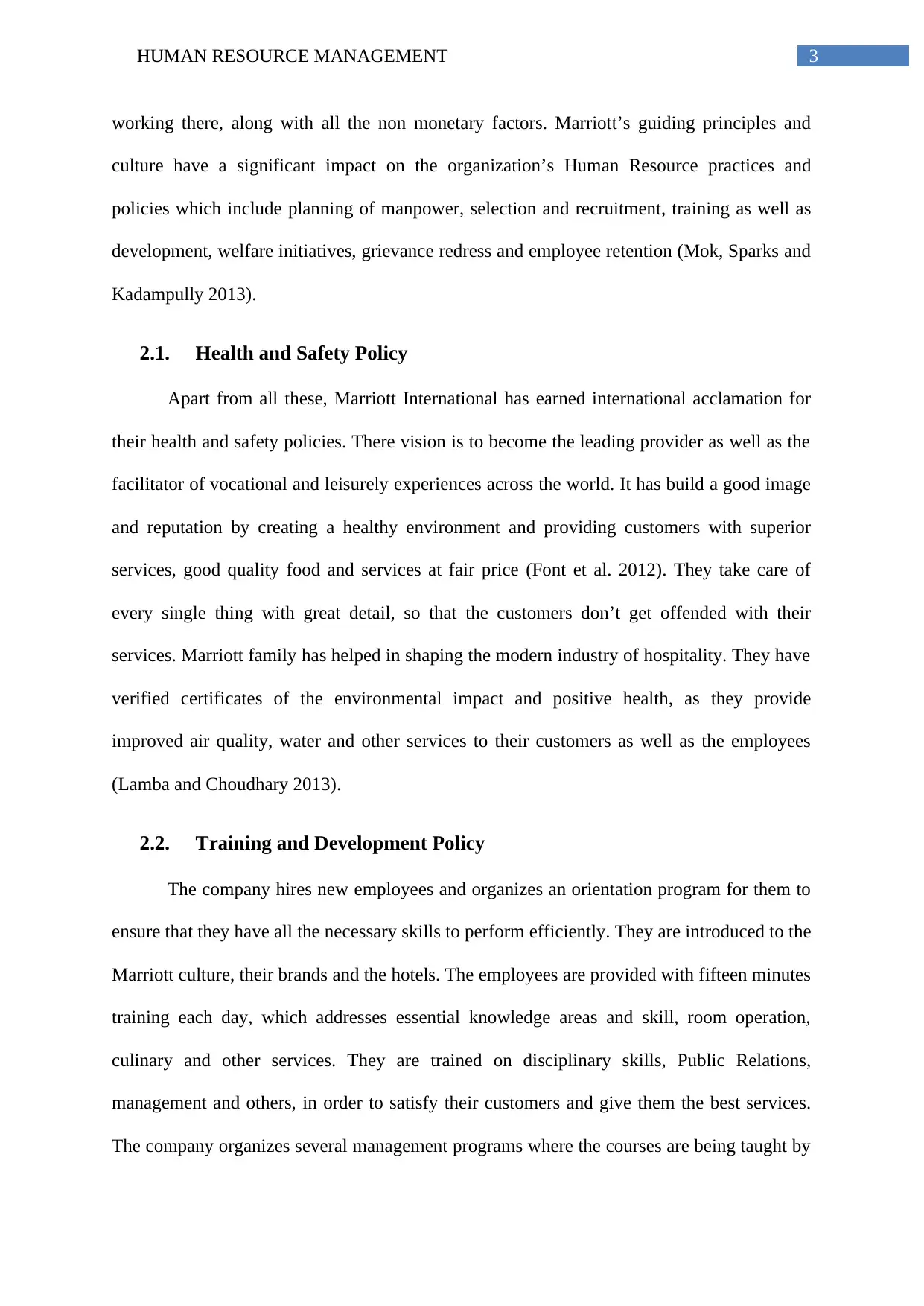
3HUMAN RESOURCE MANAGEMENT
working there, along with all the non monetary factors. Marriott’s guiding principles and
culture have a significant impact on the organization’s Human Resource practices and
policies which include planning of manpower, selection and recruitment, training as well as
development, welfare initiatives, grievance redress and employee retention (Mok, Sparks and
Kadampully 2013).
2.1. Health and Safety Policy
Apart from all these, Marriott International has earned international acclamation for
their health and safety policies. There vision is to become the leading provider as well as the
facilitator of vocational and leisurely experiences across the world. It has build a good image
and reputation by creating a healthy environment and providing customers with superior
services, good quality food and services at fair price (Font et al. 2012). They take care of
every single thing with great detail, so that the customers don’t get offended with their
services. Marriott family has helped in shaping the modern industry of hospitality. They have
verified certificates of the environmental impact and positive health, as they provide
improved air quality, water and other services to their customers as well as the employees
(Lamba and Choudhary 2013).
2.2. Training and Development Policy
The company hires new employees and organizes an orientation program for them to
ensure that they have all the necessary skills to perform efficiently. They are introduced to the
Marriott culture, their brands and the hotels. The employees are provided with fifteen minutes
training each day, which addresses essential knowledge areas and skill, room operation,
culinary and other services. They are trained on disciplinary skills, Public Relations,
management and others, in order to satisfy their customers and give them the best services.
The company organizes several management programs where the courses are being taught by
working there, along with all the non monetary factors. Marriott’s guiding principles and
culture have a significant impact on the organization’s Human Resource practices and
policies which include planning of manpower, selection and recruitment, training as well as
development, welfare initiatives, grievance redress and employee retention (Mok, Sparks and
Kadampully 2013).
2.1. Health and Safety Policy
Apart from all these, Marriott International has earned international acclamation for
their health and safety policies. There vision is to become the leading provider as well as the
facilitator of vocational and leisurely experiences across the world. It has build a good image
and reputation by creating a healthy environment and providing customers with superior
services, good quality food and services at fair price (Font et al. 2012). They take care of
every single thing with great detail, so that the customers don’t get offended with their
services. Marriott family has helped in shaping the modern industry of hospitality. They have
verified certificates of the environmental impact and positive health, as they provide
improved air quality, water and other services to their customers as well as the employees
(Lamba and Choudhary 2013).
2.2. Training and Development Policy
The company hires new employees and organizes an orientation program for them to
ensure that they have all the necessary skills to perform efficiently. They are introduced to the
Marriott culture, their brands and the hotels. The employees are provided with fifteen minutes
training each day, which addresses essential knowledge areas and skill, room operation,
culinary and other services. They are trained on disciplinary skills, Public Relations,
management and others, in order to satisfy their customers and give them the best services.
The company organizes several management programs where the courses are being taught by
Paraphrase This Document
Need a fresh take? Get an instant paraphrase of this document with our AI Paraphraser
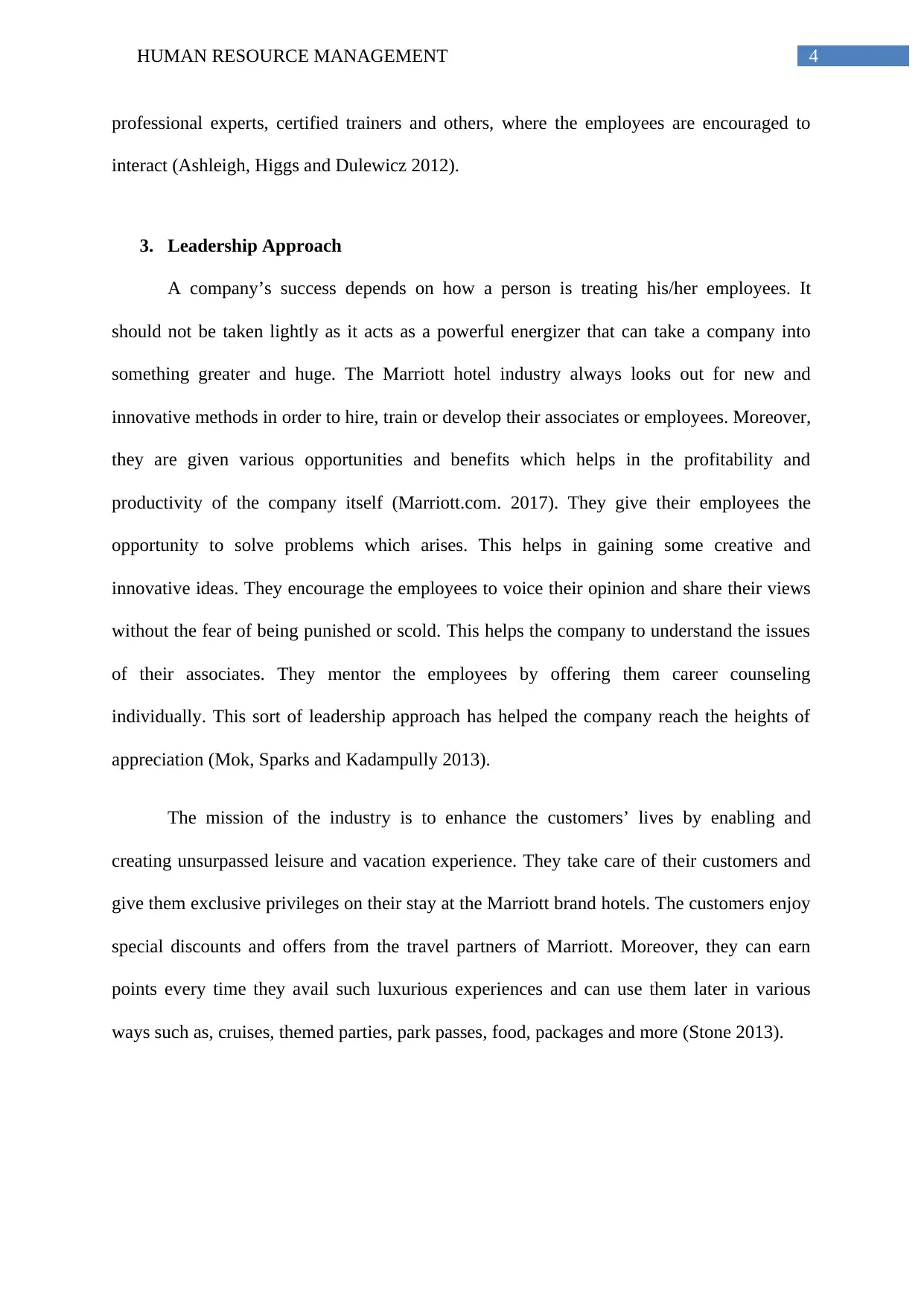
4HUMAN RESOURCE MANAGEMENT
professional experts, certified trainers and others, where the employees are encouraged to
interact (Ashleigh, Higgs and Dulewicz 2012).
3. Leadership Approach
A company’s success depends on how a person is treating his/her employees. It
should not be taken lightly as it acts as a powerful energizer that can take a company into
something greater and huge. The Marriott hotel industry always looks out for new and
innovative methods in order to hire, train or develop their associates or employees. Moreover,
they are given various opportunities and benefits which helps in the profitability and
productivity of the company itself (Marriott.com. 2017). They give their employees the
opportunity to solve problems which arises. This helps in gaining some creative and
innovative ideas. They encourage the employees to voice their opinion and share their views
without the fear of being punished or scold. This helps the company to understand the issues
of their associates. They mentor the employees by offering them career counseling
individually. This sort of leadership approach has helped the company reach the heights of
appreciation (Mok, Sparks and Kadampully 2013).
The mission of the industry is to enhance the customers’ lives by enabling and
creating unsurpassed leisure and vacation experience. They take care of their customers and
give them exclusive privileges on their stay at the Marriott brand hotels. The customers enjoy
special discounts and offers from the travel partners of Marriott. Moreover, they can earn
points every time they avail such luxurious experiences and can use them later in various
ways such as, cruises, themed parties, park passes, food, packages and more (Stone 2013).
professional experts, certified trainers and others, where the employees are encouraged to
interact (Ashleigh, Higgs and Dulewicz 2012).
3. Leadership Approach
A company’s success depends on how a person is treating his/her employees. It
should not be taken lightly as it acts as a powerful energizer that can take a company into
something greater and huge. The Marriott hotel industry always looks out for new and
innovative methods in order to hire, train or develop their associates or employees. Moreover,
they are given various opportunities and benefits which helps in the profitability and
productivity of the company itself (Marriott.com. 2017). They give their employees the
opportunity to solve problems which arises. This helps in gaining some creative and
innovative ideas. They encourage the employees to voice their opinion and share their views
without the fear of being punished or scold. This helps the company to understand the issues
of their associates. They mentor the employees by offering them career counseling
individually. This sort of leadership approach has helped the company reach the heights of
appreciation (Mok, Sparks and Kadampully 2013).
The mission of the industry is to enhance the customers’ lives by enabling and
creating unsurpassed leisure and vacation experience. They take care of their customers and
give them exclusive privileges on their stay at the Marriott brand hotels. The customers enjoy
special discounts and offers from the travel partners of Marriott. Moreover, they can earn
points every time they avail such luxurious experiences and can use them later in various
ways such as, cruises, themed parties, park passes, food, packages and more (Stone 2013).
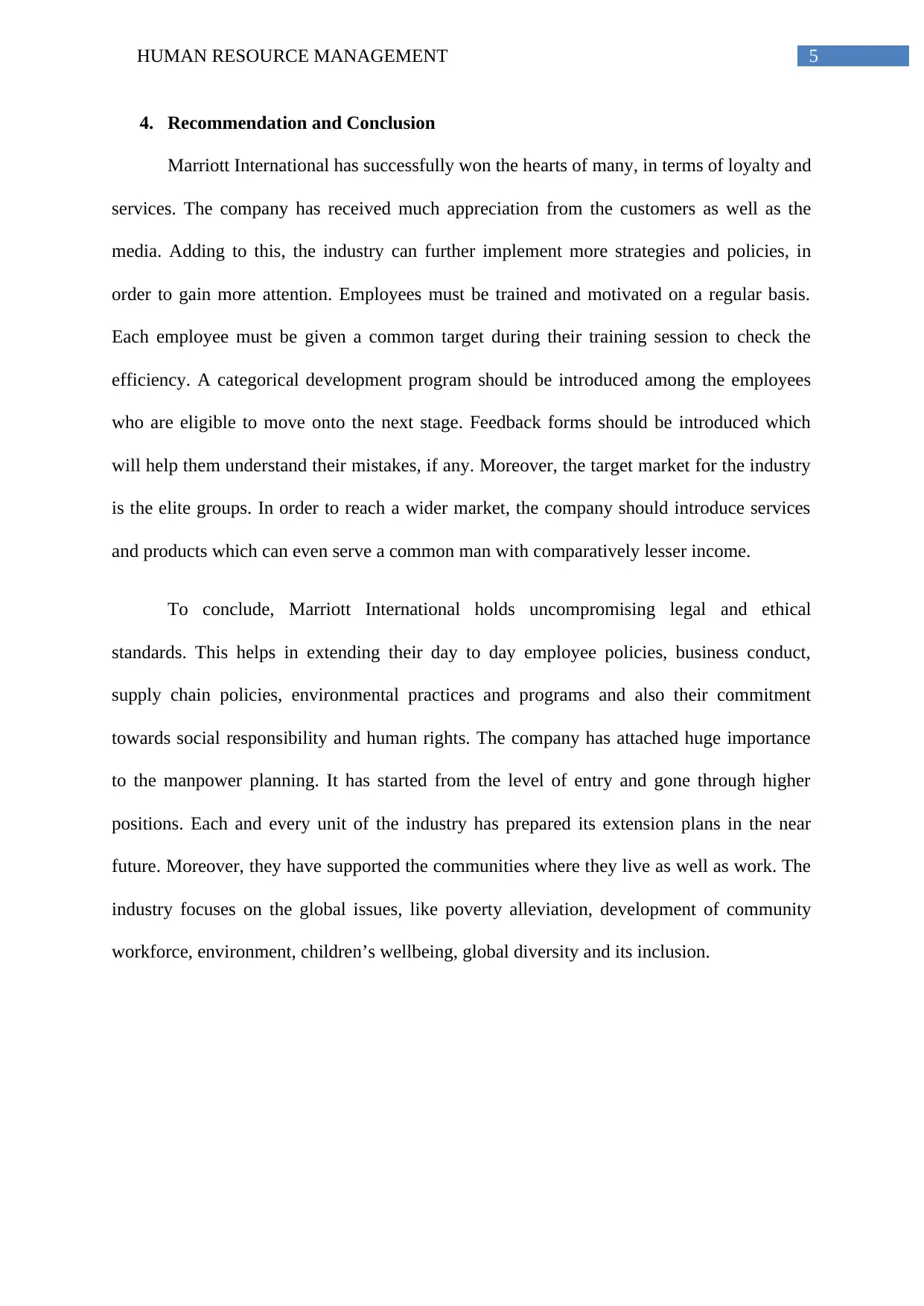
5HUMAN RESOURCE MANAGEMENT
4. Recommendation and Conclusion
Marriott International has successfully won the hearts of many, in terms of loyalty and
services. The company has received much appreciation from the customers as well as the
media. Adding to this, the industry can further implement more strategies and policies, in
order to gain more attention. Employees must be trained and motivated on a regular basis.
Each employee must be given a common target during their training session to check the
efficiency. A categorical development program should be introduced among the employees
who are eligible to move onto the next stage. Feedback forms should be introduced which
will help them understand their mistakes, if any. Moreover, the target market for the industry
is the elite groups. In order to reach a wider market, the company should introduce services
and products which can even serve a common man with comparatively lesser income.
To conclude, Marriott International holds uncompromising legal and ethical
standards. This helps in extending their day to day employee policies, business conduct,
supply chain policies, environmental practices and programs and also their commitment
towards social responsibility and human rights. The company has attached huge importance
to the manpower planning. It has started from the level of entry and gone through higher
positions. Each and every unit of the industry has prepared its extension plans in the near
future. Moreover, they have supported the communities where they live as well as work. The
industry focuses on the global issues, like poverty alleviation, development of community
workforce, environment, children’s wellbeing, global diversity and its inclusion.
4. Recommendation and Conclusion
Marriott International has successfully won the hearts of many, in terms of loyalty and
services. The company has received much appreciation from the customers as well as the
media. Adding to this, the industry can further implement more strategies and policies, in
order to gain more attention. Employees must be trained and motivated on a regular basis.
Each employee must be given a common target during their training session to check the
efficiency. A categorical development program should be introduced among the employees
who are eligible to move onto the next stage. Feedback forms should be introduced which
will help them understand their mistakes, if any. Moreover, the target market for the industry
is the elite groups. In order to reach a wider market, the company should introduce services
and products which can even serve a common man with comparatively lesser income.
To conclude, Marriott International holds uncompromising legal and ethical
standards. This helps in extending their day to day employee policies, business conduct,
supply chain policies, environmental practices and programs and also their commitment
towards social responsibility and human rights. The company has attached huge importance
to the manpower planning. It has started from the level of entry and gone through higher
positions. Each and every unit of the industry has prepared its extension plans in the near
future. Moreover, they have supported the communities where they live as well as work. The
industry focuses on the global issues, like poverty alleviation, development of community
workforce, environment, children’s wellbeing, global diversity and its inclusion.
⊘ This is a preview!⊘
Do you want full access?
Subscribe today to unlock all pages.

Trusted by 1+ million students worldwide
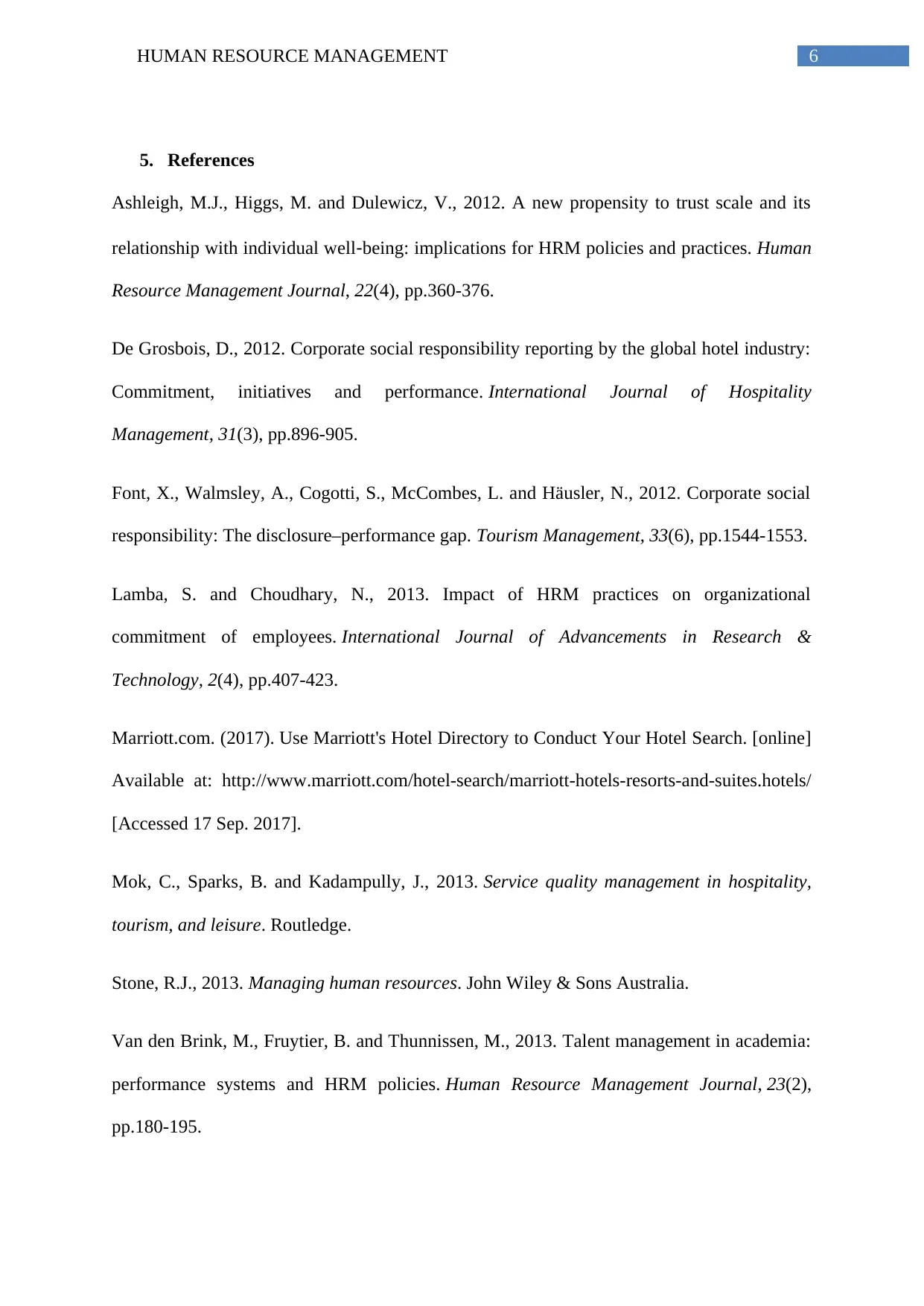
6HUMAN RESOURCE MANAGEMENT
5. References
Ashleigh, M.J., Higgs, M. and Dulewicz, V., 2012. A new propensity to trust scale and its
relationship with individual well‐being: implications for HRM policies and practices. Human
Resource Management Journal, 22(4), pp.360-376.
De Grosbois, D., 2012. Corporate social responsibility reporting by the global hotel industry:
Commitment, initiatives and performance. International Journal of Hospitality
Management, 31(3), pp.896-905.
Font, X., Walmsley, A., Cogotti, S., McCombes, L. and Häusler, N., 2012. Corporate social
responsibility: The disclosure–performance gap. Tourism Management, 33(6), pp.1544-1553.
Lamba, S. and Choudhary, N., 2013. Impact of HRM practices on organizational
commitment of employees. International Journal of Advancements in Research &
Technology, 2(4), pp.407-423.
Marriott.com. (2017). Use Marriott's Hotel Directory to Conduct Your Hotel Search. [online]
Available at: http://www.marriott.com/hotel-search/marriott-hotels-resorts-and-suites.hotels/
[Accessed 17 Sep. 2017].
Mok, C., Sparks, B. and Kadampully, J., 2013. Service quality management in hospitality,
tourism, and leisure. Routledge.
Stone, R.J., 2013. Managing human resources. John Wiley & Sons Australia.
Van den Brink, M., Fruytier, B. and Thunnissen, M., 2013. Talent management in academia:
performance systems and HRM policies. Human Resource Management Journal, 23(2),
pp.180-195.
5. References
Ashleigh, M.J., Higgs, M. and Dulewicz, V., 2012. A new propensity to trust scale and its
relationship with individual well‐being: implications for HRM policies and practices. Human
Resource Management Journal, 22(4), pp.360-376.
De Grosbois, D., 2012. Corporate social responsibility reporting by the global hotel industry:
Commitment, initiatives and performance. International Journal of Hospitality
Management, 31(3), pp.896-905.
Font, X., Walmsley, A., Cogotti, S., McCombes, L. and Häusler, N., 2012. Corporate social
responsibility: The disclosure–performance gap. Tourism Management, 33(6), pp.1544-1553.
Lamba, S. and Choudhary, N., 2013. Impact of HRM practices on organizational
commitment of employees. International Journal of Advancements in Research &
Technology, 2(4), pp.407-423.
Marriott.com. (2017). Use Marriott's Hotel Directory to Conduct Your Hotel Search. [online]
Available at: http://www.marriott.com/hotel-search/marriott-hotels-resorts-and-suites.hotels/
[Accessed 17 Sep. 2017].
Mok, C., Sparks, B. and Kadampully, J., 2013. Service quality management in hospitality,
tourism, and leisure. Routledge.
Stone, R.J., 2013. Managing human resources. John Wiley & Sons Australia.
Van den Brink, M., Fruytier, B. and Thunnissen, M., 2013. Talent management in academia:
performance systems and HRM policies. Human Resource Management Journal, 23(2),
pp.180-195.
1 out of 7
Related Documents
Your All-in-One AI-Powered Toolkit for Academic Success.
+13062052269
info@desklib.com
Available 24*7 on WhatsApp / Email
![[object Object]](/_next/static/media/star-bottom.7253800d.svg)
Unlock your academic potential
Copyright © 2020–2025 A2Z Services. All Rights Reserved. Developed and managed by ZUCOL.





